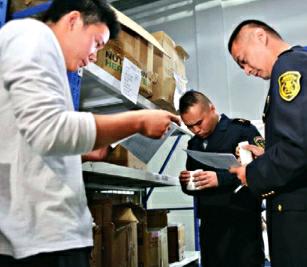Economy
2016-12-14
China Establishes Cross-border E-commerce Quality-Monitoring Center
A national quality-monitoring center for cross-border e-commerce was launched at the end of October in Hangzhou, Chinas e-commerce capital.
The platform monitors the quality and safety of cross-border commodities, analyzes relevant data and identifies potential risks, creating a safer and more trustworthy e-commerce environment.
China has stepped up its supervision of cross-border e-commerce in order to reduce risks to health and safety posed by fake products sold on e-commerce platforms through illegal channels. These products are often made from poor quality materials or use rancid animal or plant ingredients.
Wang Yichen, an official with the Hangzhou Entry-Exit Inspection and Quarantine Bureau, said that the center monitors the development of the industry, conducts quality source tracing, and evaluates various risks brought about by new technologies and products.
The centers first partnership is Alibabas cross-border retail import platform Tmall International, where staff spot-check goods in Alibabas bonded warehouse in Zhejiang Province before they are sold online.
Over the past few years, the volume of Chinas cross-border e-commerce has flourished, with an annual increase of 30 percent. China currently has over 5,000 cross-border e-commerce platforms. The Ministry of Commerce predicts the volume of cross-border ecommerce will reach RMB 6.5 trillion by the end of 2016 and that it will soon account for 20 percent of Chinas foreign trade.
China-Georgia FTA Negotiations Wrapped up
The Chinese Commerce Minister Gao Hucheng and the Georgian First Vice Prime Minister Dimitry Kumsishvili (who is also the Minister of Economy and Sustainable Development) signed a memorandum of understanding in Tbilisi, Georgia in early October, signifying that China and Georgia have finished substantive negotiations on a bilateral free trade agreement (FTA).
The FTA negotiations began in December 2015, and consisted of three rounds of official negotiations and three informal consultations. The two parties have agreed on zero tariffs for most commodity trade and pledged to open markets in the service sector, improve trade rules and identify key areas for enhanced cooperation.
The agreement consists of 17 chapters, covering such areas as commodity trade, service trade, and intellectual property, and including emerging issues like e-commerce and the environment.
The Ministry of Commerce has stated that the China-Georgia FTA is expected to boost bilateral ties in economy and trade, benefit the peoples of both countries, and promote the implementation of the Belt and Road Initiative.
The FTA still has to go through a series of legal procedures. It is expected to be officially signed in mid-2017 and take effect at the end of next year.
Annual Limit to be Set on Rare Earth Mining by 2020
China will limit its annual mining quota of rare earth to within 140,000 tons by 2020 in an attempt to crack down on illegal exploitation. This new target was announced in a Rare Earth Development Plan for the 2016-2020 period, released by the Ministry of Industry and Information Technology (MIIT).
The government will continue to investigate and punish anyone involved in illegal mining, processing or trade in rare earth metals. Market access will also be subject to improved controls.
Rare earth comprises a class of 17 mineral elements, which are non-renewable resources. These elements are some of the most sought-after metals due to their extensive application in areas like new energy transport and electronics.
With its abundant rare earth resources, China has become the worlds largest rare earth producer and exporter.
However, the industry is beset with problems, such as illegal mining and processing, as well as smuggling and a lack of homegrown technologies. Excessive exploitation has also caused significant environmental damage. During the 12th Five-Year Plan period (2011-2015), 14 illegal rare earth mines and 28 companies were shut down. More than 36,000 tons of illegal rare earth products were seized, and fines amounting to RMB 230 million were imposed, according to statistics from the MIIT.
To upgrade and optimize the structure of the industry, the MIIT plans to improve efficiency in resource management and technological innovation by 2020, focusing on developing high-end materials and equipment.
Pharmaceutical Sector Maintains Rapid Growth Towards 2020
Chinas pharmaceutical sector will maintain rapid growth as it heads towards 2020, with its main business revenue showing a healthy annual growth of more than 10 percent, according to the Planning Guidance for the Pharmaceutical Industry jointly released by multiple government departments, including the Ministry of Industry and Information Technology and the Ministry of Commerce.
From 2011 to 2015, added industrial value in the sector grew at 13.4 percent year on year. Business revenue in the sector registered an average annual growth of 17.4 percent and annual profit expanded by 14.5 percent, both much higher than other sectors.
Statistics show that pharmaceutical enterprises above the designated scale invested about RMB 45 billion in research and development in 2015, quadrupling that of 2010. The document proposed that companies increase their investment in research and development to a level accounting for more than 2 percent of their combined revenue by 2020.
The guidance states that by 2020, the enterprises capability for innovation should be substantially enhanced, their product quality should meet higher standards, and international cooperation should be increased. The sectors energy consumption, carbon emissions and water consumption, meanwhile, should drop to below the 2015 levels.
The guidance also encourages the development of big data in the healthcare and pharmaceutical industries; the incorporation of rehabilitation equipment assisted by artificial intelligence; the use of cloud services; and a long-distance clinical healthcare system, which would enable patients to have consultations, book appointments and view test results online.
Owing to improved economic conditions, Chinese people are paying more attention to health-related services. Chinas huge population and aging society has created an enormous market. New Internet-related technologies will revolutionize the sector. It is expected that the gross value of Chinas healthcare sector will exceed RMB 8 trillion by 2020.
